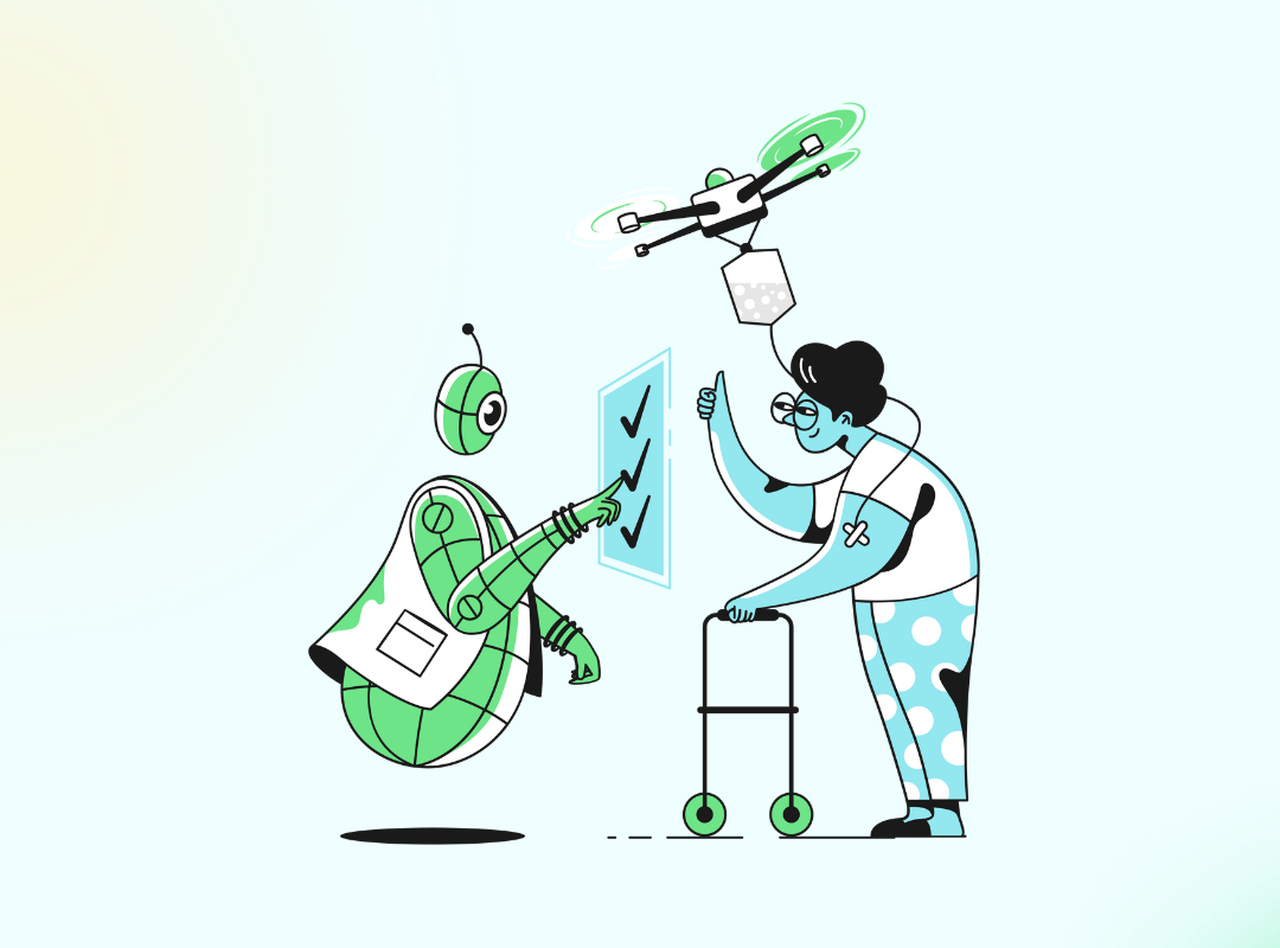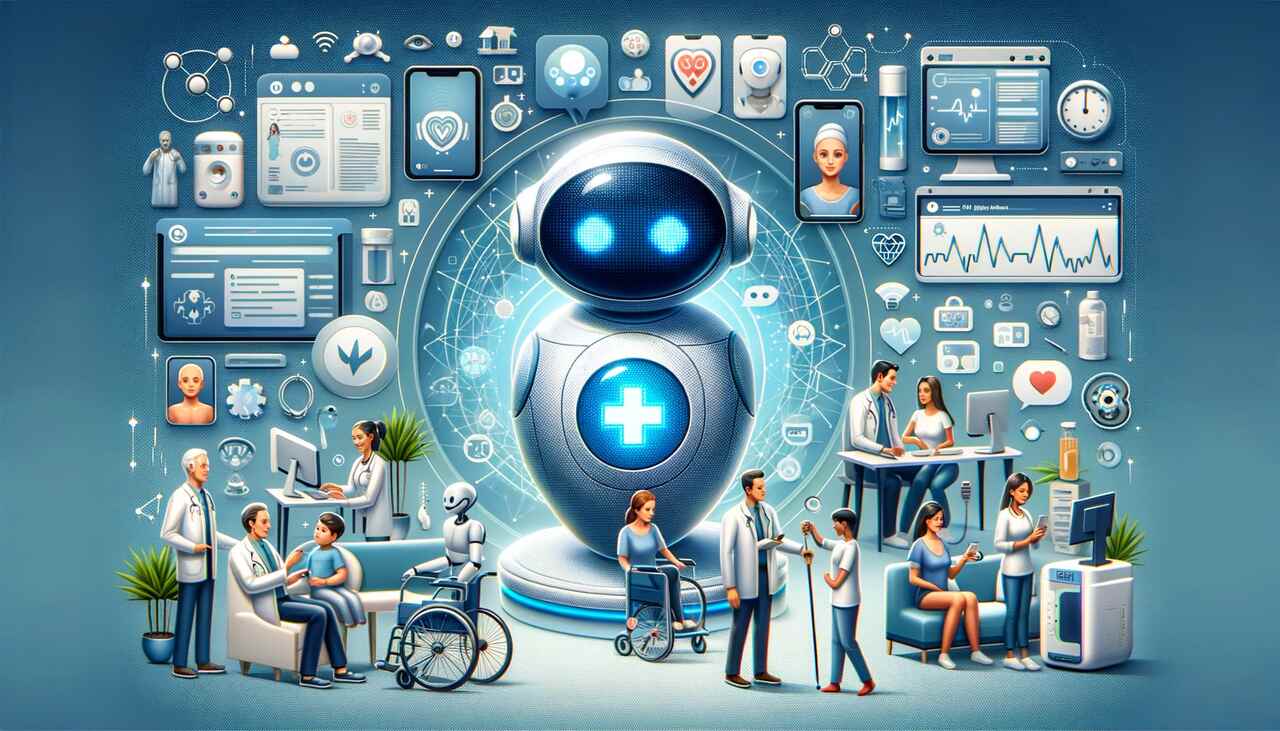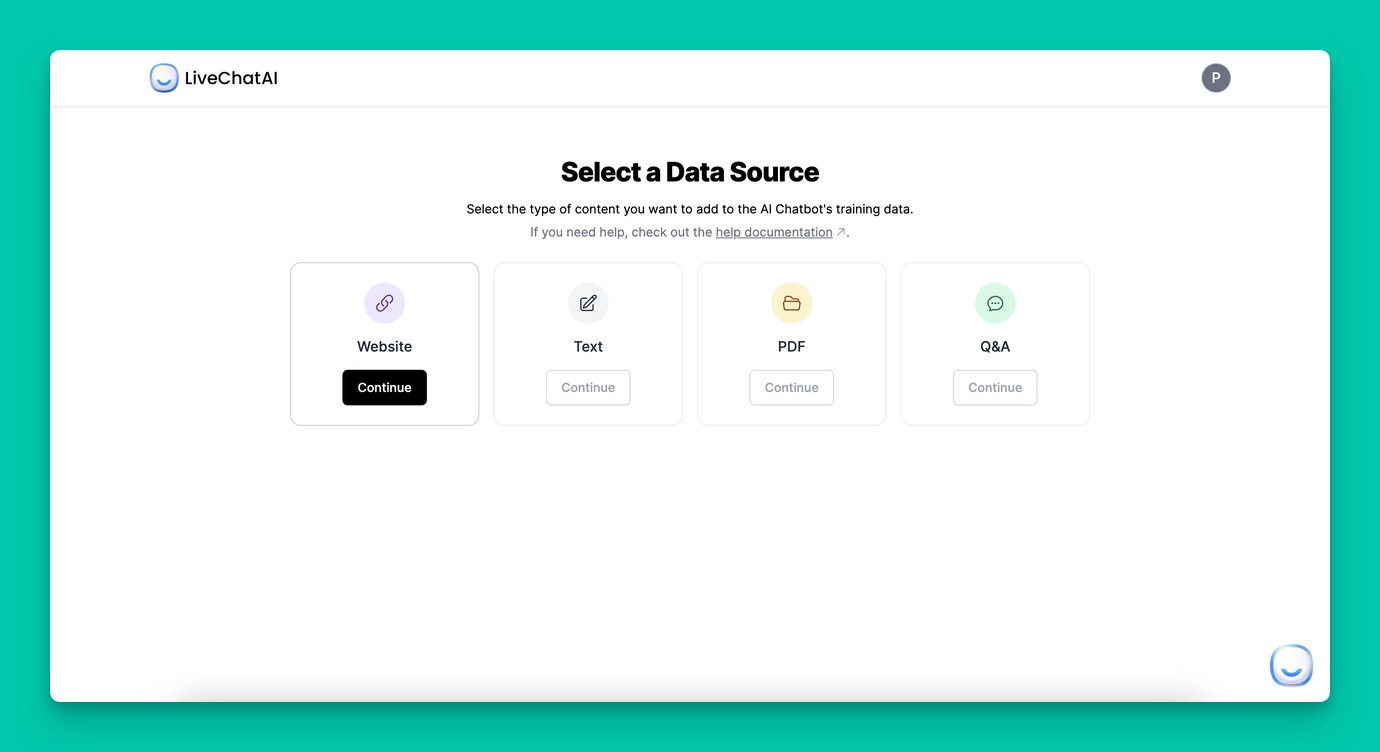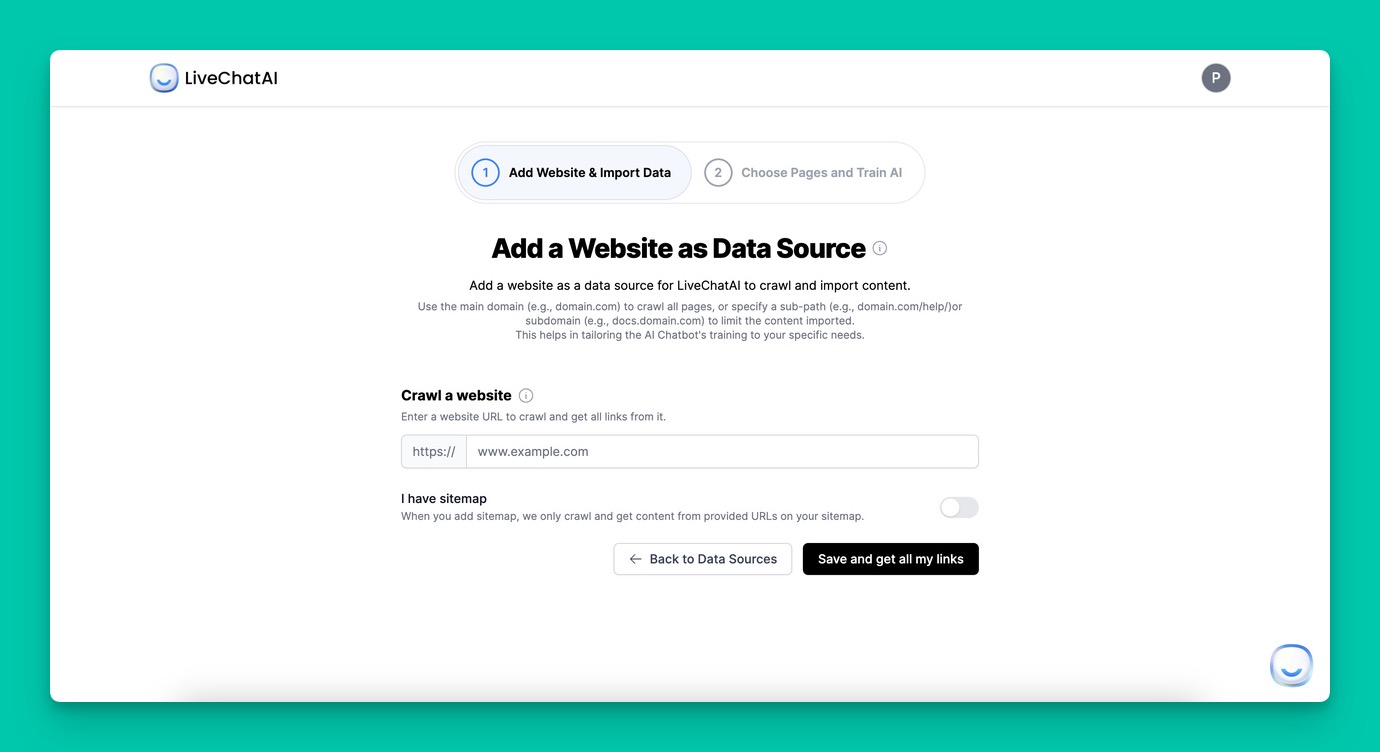
How to Use AI Chatbots for Healthcare- 17 Best Practices
As technology becomes increasingly integral to our lives, it's crucial to understand and leverage AI in sectors like healthcare.
We aim to provide an insightful journey into healthcare chatbots, from their basic definition to the technical intricacies driving their growing popularity.
Learn about their relevance, functionality, and the careful steps involved in building an effective healthcare AI chatbot.
Dive into this post to unlock the potential of AI in revolutionizing healthcare services.
What is a Healthcare Chatbot?
A healthcare chatbot is an AI-driven tool capable of simulating interactive human conversation. Utilizing Natural Language Processing (NLP), it interprets user inputs and offers precise responses, enhancing patient communication.

Healthcare chatbots are becoming increasingly necessary as they can manage multiple patient interactions simultaneously, providing a timely and efficient communication channel. Being available 24/7, these bots make healthcare assistance accessible anytime - a significant advantage to patients.
The operational process of healthcare chatbots involves receiving user input, interpreting it via NLP, accessing relevant data, and delivering an appropriate response. This dialogue system allows the bot to learn and assist in various healthcare scenarios. as a healthcare AI agent.
In the grand perspective of AI in healthcare, chatbots are playing a key role by elevating patient experiences, broadening healthcare accessibility, and reducing costs, making them a growing trend in the healthcare sector. They aren't just interactive tools but learning entities contributing to the effectiveness and efficiency of healthcare services.
The Impact of AI Chatbots in Healthcare
AI chatbots in healthcare aren't just a novel concept, but rather a groundbreaking revolution, that's causing significant changes in the entire healthcare landscape.
Let's dive deeper to understand how these technological marvels are exactly causing a disruption.
How are Healthcare Chatbots Bringing Disruption?
If we were to symbolize the healthcare sector, it would be an ancient colossal ship - strong, steady, but resistant to change. However, we see an untold shift with the advent of AI chatbots in healthcare.
Like a sea breeze that is slowly but surely turning the ship's course. It's important to note that these changes are not abrupt but are subtly interspersed across the healthcare matrix.
When we talk about disruption, it's easy to perceive it negatively. However, these AI-induced changes are far from being damaging; they are transformative, leading the way to more efficient, patient-centered healthcare.

Healthcare Chatbots are leading disruptions in several ways:
1. Improved Accessibility: Healthcare chatbots, being accessible 24/7, are helping people from all walks of life get the medical attention or information they need quickly and efficiently. They bridge the gap between healthcare services and potential patients, especially those who might otherwise face geographical or time-bound barriers.
2. Increased Efficiency and Productivity: Chatbots greatly reduce the workload on healthcare providers by streamlining appointment scheduling, answering widespread queries, and maintaining patient records. This not only enhances efficiency and productivity but also allows healthcare professionals to focus on more critical aspects, thereby improving overall healthcare delivery.
3. Enhanced Patient Engagement: With the ability to engage with patients on a personal level, healthcare chatbots are transforming patient experience and satisfaction. They provide the required information, answer queries, or offer support almost instantaneously — facilitating a smoother patient journey.
4. Reduced Costs: Automating routine tasks and customer service, AI chatbots considerably bring down overall operational costs for healthcare institutions, paving the way for affordable healthcare solutions.
Why Use AI Chatbots in Healthcare?
The question to ask really isn’t why use AI chatbots for healthcare, but rather, how can we afford not to? With the unstoppable growth of digitization, AI has been making waves across industries, and healthcare is no exception.
By now, we have painted a vivid picture of what AI chatbots are and their transformative potential in the healthcare realm.
But why exactly should we use AI chatbots in healthcare? What are the significant benefits of chatbots in healthcare? Let’s dive in and see.
Benefits of Chatbots in Healthcare
Harnessing the power of AI chatbots for healthcare is synonymous with stepping into an era where healthcare delivery is efficient, personalized, and most importantly, patient-centric. Here's a comprehensive list of the benefits of chatbots in healthcare.
1. Enhanced Patient Engagement
AI chatbots are adept at engaging patients through interactive and intuitive conversations. These AI-powered platforms can provide personalized health tips, track health goals, send appointment reminders, and even perform follow-ups post-checkups or treatments. High patient engagement is a key driver of better health outcomes and improved patient satisfaction.
2. 24/7 Availability
One of the biggest benefits AI chatbots offer in healthcare is around-the-clock availability. Unlike their humane counterparts, AI chatbots never tire or take breaks. They are available to answer queries, schedule appointments, and assist patients 24/7. This round-the-clock availability significantly enhances healthcare service, ensuring patients have access to care or information anytime they need it.
3. Automated and Streamlined Administrative Tasks
AI chatbots can entirely handle administrative tasks, such as scheduling appointments, sending reminders, answering frequently asked questions, documenting patient data, etc. Automating these tasks considerably reduces the administrative load on healthcare professionals, allowing them to devote more time to critical cases.
4. Early Detection and Prevention of Diseases
AI chatbots can be programmed to ask symptom-specific questions, perform preliminary diagnoses based on reported symptoms, and recommend actions. This helps in early detection and prevention of diseases, leading to effective treatment and better patient outcomes.
5. Monitors Patients’ Health Status
Another advantage is the use of AI chatbots for constant monitoring of patient's health status. They can track vital signs such as blood pressure, blood sugar levels, heart rate, etc., and immediately alert medical professionals in case of abnormalities.

6. Cost-effective Healthcare
By automating routine tasks, reducing unnecessary appointments, and helping in the proactive management of health, AI chatbots help lower healthcare costs, making it more affordable and accessible for everyone.
7. Improved Access to Healthcare Information
With the easy availability of massive amounts of health-related information, patients today are more informed than ever. However, getting relevant and reliable information is critical. AI chatbots step in by providing accurate, referenced, and personalized healthcare information to users. They can provide advice, clarify doubts, and explain medical terms in an easy-to-understand manner.
8. Personalized Patient Experience
AI chatbots leverage data to deliver personalized responses, suggestions, and reminders, ensuring a uniquely tailored patient experience. Over time, with more interactions, chatbots learn and understand a patient’s personal needs and preferences, thereby delivering even more personalized care.
9. Ease in Insurance Claims
AI chatbots can also streamline the insurance claim process by assisting policyholders in filling out forms, explaining terms and conditions, calculating claim amounts, and expediting the overall claim process.
10. Confidentiality
AI chatbots adhere to the strictest norms of data privacy and -security. They offer a comfortable and secure atmosphere where patients can discuss their symptoms and concerns freely, knowing their information is confidential.
These advantages are making AI chatbots unique additions to the sector, creating a healthier, more patient-focused healthcare system.
While AI chatbots can never replace human medical professionals, they certainly can aid in providing superior care and outcomes.
In this era of technological progression, the 'How to use AI chatbots for healthcare' case has become a must-learn chapter.
AI offers the potential to improve the patient experience profoundly, streamline the healthcare delivery process, make healthcare services more affordable and accessible, and much more.
How to Use AI Chatbots in Healthcare
In the wake of the technological revolution, healthcare remains no stranger to the scarcely believable wonders of Artificial Intelligence (AI).
AI chatbots, with their plethora of applications, have transformed the healthcare landscape into an efficient machine, working tirelessly towards creating a patient-centric healthcare model.
Notably, these aren't just words. Figureheads in the healthcare industry have adopted AI chatbot applications to improve efficiency, and they have witnessed positive results.
The right question thus isn't 'Why use AI chatbots for healthcare?' but more along the lines of 'How can AI chatbots revolutionize healthcare?'
With that set, let's put on our adventure gear and embark on this exciting journey of discovering the top use cases of chatbots in healthcare.
Top Use Cases of Chatbots in Healthcare
Every aspect of modern healthcare, from advice to diagnosis, from treatment to follow-up, has applications for AI chatbots.
To make our journey friendlier, let's split these applications across four main domains:
1. Information Delivery and Education
2. Data Analysis and Management
3. Doctors and Medical Staff Facilitation
4. Appointment Scheduling and Follow-up
Let's explore each!
1. Information Delivery and Education
Consider this scenario: you're feeling a tad under the weather. Maybe it's a fever, or that annoying headache won't leave you alone. You find yourself scouting the internet for possible reasons - could it be stress? Allergies? Or are you just usually tired?
Here's where healthcare bots kick in. They deliver reliable and customized information, either through websites or mobile apps, based on your reported symptoms.
As interactions progress, bots can even educate users on possible health precautions, personal health management, lifesaving procedures, and medical emergencies. Thus, healthcare bots can act as go-to medical advisors any day!
A shining example of information delivery using AI chatbots is Babylon Health's AI chatbot. It leverages AI to allow users to type their symptoms and then analyzes the inputs using its algorithm.
Based on the symptoms and the user's medical history, the bot provides valuable health info, making medical advice accessible to everyone.
2. Data Analysis and Management
The healthcare industry deals with an ocean of data - patient reports, medical histories, doctor notes, insurance data, and several others.
A significant challenge is to efficiently manage this data and leverage it. AI chatbots swoop in as saviors, sorting, categorizing, storing, and analyzing data, thus enhancing data management on a large scale.
Furthermore, AI chatbots can sift through these massive data sets to extract invaluable insights. They can predict trends, coming epidemics, potential health risks, success rates of different treatments, and much more.
Take the example of IBM Watson - a preeminent AI system. Watson understands, learns, and reasons out from large data sets across several areas, healthcare being one.
It goes through millions of pages of medical textbooks and numerous case studies to prepare a database that can assist doctors in diagnosing diseases.

3. Doctors and Medical Staff Facilitation
AI chatbots can make the lives of doctors, nurses, and medical staff much easier. From managing their schedules, assisting in surgeries, and delivering quick references to drug-drug interactions to even aiding doctors in decision-making by analyzing patient history and the latest research papers, AI chatbots can revolutionize their workspace.
The HoloLens system is a classic example in this domain. It encompasses mixed reality smart glasses that can overlay digital records during patient checkups or surgeries or even provide real-time guidance to doctors during complex surgeries.
4. Appointment Scheduling and Follow-up
Appointment Scheduling is commonly managed by AI chatbots more than ever. They track doctor schedules, suggest suitable times for patients, and even manage changes and cancellations smoothly. Patients can book an appointment, ask about clinic hours, inquire about a doctor's availability, and more through chatbots.
AI chatbots also handle follow-ups. They connect with patients after doctor visits or treatments, provide guidance for at-home care or medication regimens, and even help set reminders for medication or next appointments.
Zocdoc, an online medical care appointment booking service, uses AI to schedule doctor appointments. The AI monitors doctor schedules and the nature of medical issues and assigns appointments accordingly.
That was quite a journey, right? It's clearly beyond the shadow of a doubt that AI chatbots have several high-impact applications in healthcare and are leading the way toward a digitized and efficient healthcare model.
Each of these use cases iterates the vital role AI chatbots are playing in healthcare and hints at future advancements that can further transform this space. The idea is to integrate AI chatbots in healthcare to amplify human abilities and not replace them.
How to Evaluate AI Healthcare Chatbot Performance Metrics
The importance of chatbots in the healthcare domain is unequivocal, but are these bots performing up to the mark? If so, by which standards? If not, what improvements are required?
To answer these, we need to measure the performance of our AI chatbots.
We’ll be examining a case study - Ada Health, an AI-powered health companion.
1. User Satisfaction Rate
One of the primary measures of chatbot performance, user satisfaction rate, measures how satisfied users are with their interactions with the chatbot. This can be determined through surveys or direct feedback mechanisms.;
→ Ada Health boasts a high user rating of 4.8 out of 5 over millions of users on the App Store and Google Play. This high score indicates overall user satisfaction with the bot's performance.
2. Chatbot Comprehension Ability
This metric measures the chatbot's ability to understand user input. The ability to accurately comprehend the user’s intent, sentiment, and context ensures effective communication and increases the likelihood of task completion.
→ Ada's chatbot leverages AI to understand users' health symptoms and medical history accurately. It can then list potential diseases or conditions that match the symptoms.
3. User Retention Rate
How often does a user return to interact with the bot? A good bot will not only attract users but will make them come back. The user retention rate provides insights into the value that users derive from their interactions with the bot.
→ Ada Health has managed to entice a lot of users back to the app, indicating high user retention.

4. Bot Response Time
From a user’s perspective, the quicker a bot responds, the better. A low bot response time significantly enhances user experience.
→ Ada's chatbot has impressively quick response times, often providing immediate solutions and guidance on your health conditions.
5. First Contact Resolution
This metric gauges whether the bot was able to completely address the user’s query or task in the first interaction itself. This can vastly improve user satisfaction and efficiency of service.
→ Ada Health's AI bot leverages deep learning algorithms and an extensive medical knowledge base to solve most user queries on the first contact.
6. Learning & Evolving Capabilities
Measuring a bot's ability to learn and evolve from past interactions is crucial. It shows how well the AI part of the bot is functioning.
→ The AI bot continually refines its algorithms based on user feedback, demonstrating strong adaptability.
AI Chatbots for Specialized Healthcare Services
AI chatbots in healthcare are designed to facilitate patient care, engage users in maintaining their health, and assist with various healthcare services.
They are purposed for different healthcare niches and offer personalized, on-demand services, answering health queries, guiding through health conditions, providing therapeutic procedures, or assisting with medication and treatment management.
Now let's dive into specific cases:
1. Mental Health Services: For instance, Woebot and Wysa provide cognitive-behavioral therapy (CBT) techniques, assisting users in managing stress, anxiety, and other mental health issues.
2. Chronic Condition Management: AI chatbots play a crucial role in managing chronic conditions like diabetes or heart disease by reminding patients to take medication, tracking and advising on diet and exercise, and monitoring health metrics like blood sugar or blood pressure levels.
3. Women's Health: Maven and Flo specialize in women’s health, from maternity to menstrual cycle tracking, offering personalized healthcare advice and support based on the user's health data.
4. Senior Care: Chatbots like Catalia Health’s Mabu assist elderly users in daily health routines and medication reminders, acting as digital companions to help maintain their health management independence.
5. Pediatric Care: In pediatric care, AI chatbots are designed to interact with children, keeping them engaged during hospital stays or medical procedures. For instance, the Children's Hospital Los Angeles uses a chatbot named "Pepper" to assist and entertain young patients.
6. Telemedicine Services: Take 98point6 as an example; it offers on-demand, text-based primary care consultation remotely.
7. Physical Therapy and Rehabilitation: Kaia is an AI-driven physiotherapy app guiding users through physical therapy exercises for managing conditions like back pain.
8. Nutritional Guidance and Weight Management: Lark is a chatbot that provides personalized nutritional advice and weight management plans.
9. Dermatology: Aysa is a unique example of an AI chatbot that helps in dermatological care by guiding users in understanding and managing skin conditions.
10. Sleep Therapy: Tools like Sleepio integrates AI and cognitive-behavioral therapy to help users understand and improve their sleep patterns.
11. Breastfeeding Support: For new mothers, the breastfeeding chatbot, Lactation Lab, provides support and answers common questions related to breastfeeding.
12. Oncology: Noona is an AI chatbot that allows cancer patients to report symptoms and side effects of their treatment, enhancing patient-clinician communication in oncology care.
13. Pharmacology: For better understanding and management of medication, we have Medsby. It's an AI bot that educates users about their medication, including side effects, ideal consumption methods, and timings.
Designing AI Chatbots for Healthcare
As we continue our tour across the 'artificial intelligence in healthcare' landscape, the next crucial station is 'How to design an efficient healthcare chatbot?'.
For a tool as powerful and complex as an AI chatbot, the design and development process can be a challenge yet an exciting one.
If you're a healthcare provider or implementer looking to bring a chatbot on board, this guide is your stepping stone.
How to Build an Efficient Healthcare Chatbot?
Designing a Healthcare AI chatbot involves a structured process of understanding the needs, planning, building the AI engine, training it, and finally integrating it with the right platform. Here is a step-wise guide summarizing the process.
Step 1: Define your Objective
First and foremost, you require a clear and well-defined objective. You need to ask questions like - Why are you building this chatbot? What patient needs will it cater to? How will it align with and fit into your existing systems?
Step 2: Identify User Needs
After setting clear aims, your next step should be understanding your user needs. For building a healthcare AI chatbot, the prime users will be patients, doctors, or healthcare staff. Figure out their needs and their expected functionalities from the chatbot, and then build along those lines.

Step 3: Choose the Right Platform
The incorporation of a chatbot demands choosing the correct platform. Today, chatbots can be website-based or can function within popular messaging platforms like Facebook Messenger, WhatsApp, etc. Picking the right one fulfills accessibility for your users.
Step 4: Create a Chatbot Personality and Script
Designing your AI chatbot's persona resonates with your brand image and keeps the patient involved. Moreover, writing a solid script covering all potential questions and responses is an essential step in chatbot development.
Step 5: Develop your AI engine
The beacon of the chatbot, the AI engine, requires attention and focus. You will want to harness the power of machine learning and Natural Language Processing (NLP) to process patient responses and create human-like interactions.
Step 6: Train your Chatbot
Training the bot involves feeding it with healthcare data, potential queries and corresponding answers, language nuances, and user interface. Remember, the more it learns, the better it becomes!
Step 7: Test, Iterate & Improve
This is a vital step you must not miss. Test your bot, understand its shortcomings, and iterate and improve. The aim is to make it patient-friendly, efficient, and effective at resolving queries.
Step 8: Deploy and Regularly Update
Once you're confident about your chatbot, roll it out. But the process doesn't end here. The AI chatbot will need regular monitoring and updates to ensure its accuracy and reliability and to keep validating the 'AI chatbots for healthcare' narrative.
How to Create a Healthcare AI Chatbot with LiveChatAI
Creating a healthcare AI chatbot with LiveChatAI involves leveraging the platform's capabilities to cater specifically to the needs of healthcare providers and patients.
By following the general process outlined for LiveChatAI and tailoring it to healthcare, you can unlock numerous opportunities for improving patient engagement, streamlining inquiries, and providing valuable health information.
Here’s how to adapt the process:
Step 1: Account Creation and Customization
Customize your AI chatbot with a friendly, empathetic tone suitable for healthcare interactions. Consider healthcare-specific branding, including colors, logos, and language that resonates with patients and staff.

Step 2: Selecting Data Sources
- Website as Data Source: Include your healthcare organization's website to educate the chatbot about services, FAQs, and health resources.
- Text and PDFs: Add medical guides, FAQ documents, and policy PDFs to equip the chatbot with in-depth healthcare knowledge.
- Q&A Data Source: Import a list of common healthcare-related questions and answers, such as appointment booking procedures, services offered, symptoms and conditions, privacy policies, and emergency advice.

Step 3: Importing Content and Training
Focus on content that directly benefits patients and healthcare staff, such as appointment processes, patient care information, health tips, and emergency guidelines.

Step 4: Human Support Integration
Given the sensitive nature of healthcare, ensure there’s an easy option for users to connect with human support for complex or sensitive issues.

Step 5: Customization for Healthcare
- Preview: Test the chatbot with healthcare-specific scenarios to ensure responses are appropriate and empathetic.
- Settings: Adjust settings to prioritize patient privacy and data security, which is crucial in healthcare settings.
- Customize: Set up the initial message to reassure users about the confidentiality and supportiveness of the chatbot, e.g., "How can I assist you with your healthcare needs today?"
Opportunities for Healthcare AI Chatbots
- 24/7 Patient Support: Provide round-the-clock responses to patient inquiries, reducing wait times and improving patient satisfaction.
- Appointment Scheduling: Automate appointment bookings and reminders, enhancing operational efficiency.
- Symptom Checking: Offer preliminary symptom assessments, guiding patients on whether they should seek professional medical advice.
- Health Information: Educate patients with accessible health information, promoting preventative care and healthy living.
- Feedback Collection: Gather patient feedback on services, helping healthcare providers identify areas for improvement.
Conclusion
AI chatbots have significant potential to enhance the efficiency and effectiveness of healthcare services.
Their use extends beyond mere concept to practical implementation, promising improved patient experiences and outcomes.
Healthcare chatbots represent a shift towards greater accessibility in healthcare and health services for all.
Frequently Asked Questions
Can an AI chatbot make a diagnosis?
While AI chatbots are becoming increasingly sophisticated, they currently support and supplement healthcare services but do not replace professional medical advice and diagnosis. They can provide symptom assessments based on the data provided to them but should not be solely relied upon for a medical diagnosis.
Can AI chatbots in healthcare understand and respond to various languages?
Many AI chatbots are multilingual and can interact with users in various languages, making them accessible to a wider population.
Can AI chatbots handle sensitive health-related conversations?
Yes, AI chatbots can be programmed to handle sensitive health topics. They follow strict privacy and confidentiality protocols, ensuring sensitive health information is handled properly.
For further reading, you might be interested in the following:






